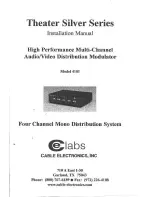
M
ORE
S
OPHISTICATED
S
YSTEMS
Sophisticated home “networks” involving many televisions
are feasible with the MOD3000. In developing a network,
care must be taken to design an optimum signal distribution
system.
TV’s are designed for signals around 10dBmV. Signals sub-
stantially below 5dBmV result in weak, fuzzy, snowy
pictures. Signals above 15dBmV may overdrive older TV sets
which don’t have modern auto gain controls (which can han-
dle signals up to 40dBmV). An in-line attenuator (pad) can
also be used to reduce these signals, and to balance
radically different signal strengths at all your televisions. The
MOD3000 has an signal output level adjustment (red screw
marked ATT on the rear of the unit) which affords you the
ability to balance (increase or decrease) modulated signal
strength for optimum performance with your existing TV set(s).
Signal strength decreases with coax cable length,
connectors, splitters and combiners, so it is important to
determine cable length and what in-line devices you will be
using. Adjustment of input signal levels with video ampli-
fiers, either in-line or at the front end of your network, will
compensate for any line losses you may experience. The
following charts will help you calculate likely losses
through coax cable runs and splitters.
SIGNAL LOSS PER 100 FEET, BY COAX CABLE TYPE
Freq
RG-11
RG-6
RG-59
400MHz
2.54dBmV
3.90dBmV
4.86dBmV
500MHz
2.87dBmV
4.93dBmV
5.46dBmV
600MHz
3.17dBmV
4.83dBmV
6.01dBmV
700MHz
3.45dBmV
5.25dBmV
6.51dBmV
800MHz
3.71dBmV
5.63dBmV
6.99dBmV
900MHz
3.96dBmV
6.00dBmV
7.44dBmV
SPLITTER SIGNAL LOSSES
Splitter
Signal Loss
2-Way
3.5dBmV
4-Way
7.0dBmV
8-Way
10.5dBmV
In-line RF amplifiers are powered through the coax
cable and can be used to achieve modest signal strength
gains. AC powered RF amplifiers offer more amplification,
higher gain (17 to 25dB) and (usually) adjustable gain and
tilt controls. Your system should provide 10dBmV to every
TV (maximum is 15.5dBmV, per FCC regulations).
Reverse isolation is used to prevent the signal from your
MOD3000 from leaking out to the cable distribution system
(which the cable company doesn’t appreciate) or broadcast-
ing off your antenna (which your neighbors won’t appreciate
either). Reverse isolation is accomplished by placing an
amplifier between your antenna or cable company input and
the MOD3000 2-Way Video Splitter. This prevents the
MOD3000 signal from traveling back up the input line.
Band pass filters stop or filter out unwanted frequencies
while passing all others along. They are handy if a channel
you want to use for a MOD3000 source is already in use.
MOD3000 Installation Instructions
ELAN Home Systems • 1999 • All Rights Reserved
Taps and directional couplers are used to redirect a
portion of a signal from a “main” line while passing the
remaining signal through. For example, a 24dBmV tap
would attenuate 24dBmV from a 30dBmV signal and
siphon the remaining 6dBmV to a branch line. (Minor signal
losses would occur in both lines).
T
ROUBLESHOOTING
Y
OUR
MOD3000 I
NSTALLATION
Try these “remedies” for the problems we have listed
below. If all else fails, call ELAN Home Systems Technical
Support for assistance at 1 (800) 622-ELAN (3526), Monday
thru Friday, 9:00AM to 6:00PM EST.
No Picture At All
Check cable connections. Check cable/antenna mode or
programmable feature on television set. Check MOD3000
Channel range/band DIP switches for proper setting.
Snowy Picture (Weak Signal)
Check cable connections. Increase signal level output of
MOD3000 by turning ATT control pot (red) clockwise. Add
signal amplifier in-line before splitter output.
Lines In TV Picture (Signal Too Strong)
Reduce signal level output of MOD3000 by turning ATT
control pot (red) counter clockwise. If using a signal amplifi-
er, remove it, decrease output, or move it “further up” the
cable line. Add attenuator in line.
Lines In Video Source Picture
Confirm modulated channel has no interference from broad-
cast signals (“clean snow” prior to channel assignment).
TV Picture Is “Ghosting” (FM or Multiple
Signals, Interference)
Make sure all video ports are terminated. Install video
amplifier between antenna input and 2 to 1 video combiner.
Video Source Picture Is Overly Bright
OR Overly Dark
On the bottom panel of the MOD3000, directly beneath the
video source inputs are Picture Quality Level adjustments
for each video source input channel (A, B, and C). Normally,
video source equipment output signals are factory set at one
volt peak to peak, and should not need to be adjusted for. In
some cases, an adjustment on the MOD3000 will need to
be made to compensate for weak or strong signal inputs
from source equipment. Identify which video source input
channel (A, B, or C) needs adjustment and go to that adjust-
ment screw (you will need a small Phillips screwdriver).
If the picture is overly bright and flooded with color, turn the
screw counter-clockwise slightly until the picture exhibits






















